The flavors meld so well, and that Aburaage adds a unique touch. Totally making this again!
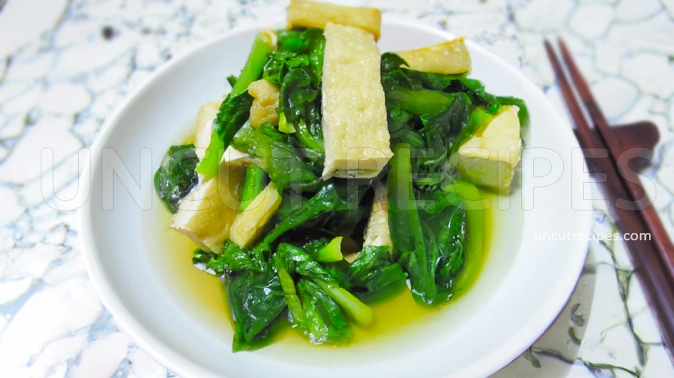
Discover the refreshing simplicity of Komatsuna Nibitashi, a classic side dish straight from the heart of Japanese cuisine. Meticulously crafted to complement any main course and steamed rice, this dish is a symphony of light, wholesome flavors.
Komatsuna, often dubbed as mustard spinach in English, adds a hint of pleasant bitterness, melding seamlessly with the subtle seasoning of the Nibitashi technique. In the world of Japanese gastronomy, Nibitashi stands out as a method that celebrates the essence of each ingredient. Braising vegetables in a seasoned broth, allowing them to soak up every note of flavor, ensures a rich taste without being overly indulgent.
And for those who yearn for a deeper, heartier undertone, the addition of Aburaage, or deep-fried thin tofu, can be a game-changer. Craving more? Incorporate succulent chicken thighs to elevate the richness of your Komatsuna Nibitashi. Dive into this harmonious dish and experience a genuine taste of Japanese culinary tradition.
JUMP TO:
INGREDIENTS:
Komatsuna: Komatsuna, or Japanese mustard spinach, is the star ingredient in this dish. When selecting Komatsuna, opt for ones with vibrant green leaves and sturdy stems. The leaves should be free from blemishes, wilting, or yellowing, signaling freshness and optimal nutrition. The stems should be crisp to touch. The younger, tender Komatsuna leaves are preferable as they possess a milder flavor, perfect for this dish.
Komatsuna Substitute: If you can't find Komatsuna, other leafy greens such as spinach, swiss chard, napa cabbage, cabbage or mizuna can be used in its place. The flavor and texture may slightly vary, but the method will largely remain the same.
Aburaage: Aburaage is deep-fried tofu pouches. When selecting, the texture should be slightly spongy yet firm to the touch. It should have a light golden-brown color. If buying pre-packaged, ensure there's no excessive oil seeping. Freshness is essential, so always check the expiry date.

Aburaage Substitute: Thin slices of firm tofu, Atsuage, thick deep-fried tofu or satsumaage and deep-fried fish cake, can be an alternative to Aburaage.
Bonito Dashi: Bonito Dashi is a foundational Japanese stock made from dried bonito flakes. To ensure the highest quality, consider making it fresh at home using dried bonito flakes and kombu seaweed. However, if you're buying ready-made bonito dashi, look for authentic Japanese brands and ensure there aren't any unnecessary additives. A clear, amber-colored dashi indicates proper preparation. If in a hurry, dashi packets, similar to tea bags but filled with bonito and kombu, can be a quicker alternative – just steep in hot water.
Bonito Dashi Substitute: For those who prefer a different type of dashi, Kombu (kelp) or Shiitake mushroom dashi can be used as a replacement.
MAIN STEPS:
Komatsuna Integrity: While slicing the Komatsuna, retain uniformity in size. This ensures even cooking, preserving the vegetable's nutrients and texture. Overcooking them might result in a mushy texture, and you'll lose their natural vibrant green, which adds aesthetic appeal to the dish.
Aburaage Preparation: Aburaage, being tofu-based, absorbs flavors well. While slicing them, maintaining even strips ensures that they soak up the broth uniformly. Prepping them correctly can make the difference between a fully flavored bite and a bland one.
The Broth's Delicate Balance: When preparing the broth, heat it gently. Overheating can cause the alcohol in the Sake and Mirin to evaporate too quickly, altering the desired flavor profile. Slowly heating ensures the melding of flavors and prevents any one ingredient from overpowering the others.
Simmering Secrets: In step 06, simmering is vital. A gentle simmer, as opposed to a roaring boil, allows the Komatsuna and Aburaage to gradually absorb the flavors without compromising their structure. Monitor closely to avoid overcooking, aiming for the Komatsuna to be tender but not wilted.
Rest and Absorb: Post-cooking, letting the dish sit covered is essential. It's during this resting phase that the flavors truly meld, with the Komatsuna and Aburaage absorbing the savory broth further. This elevates the dish's depth and ensures that every bite is flavor-packed.
Serving Temperature: Serving at room temperature often allows the flavors to shine best. However, if you choose to reheat, do so gently to avoid overcooking the Komatsuna, preserving its crunch and the overall dish's integrity.
SERVED WITH:
Starter: Edamame (Japan): Tender young soybeans, boiled to perfection and lightly salted. This simple yet flavorful dish provides a protein-packed start to any meal.
Side Dish: Gyoza (Japan): Crescent-shaped dumplings filled with a mixture of minced meat and finely chopped vegetables. They are pan-fried to a crispy bottom, steamed to tenderness, and usually served with a soy-vinegar dipping sauce.
Side Dish: Oden (Japan): A heart-warming pot of assorted ingredients, like daikon radish, boiled eggs, and fish cakes, stewed in a light soy-flavored broth, perfect for cold days.
Main Course: Bibimbap (Korea): A vibrant rice bowl topped with an array of sautéed and fresh vegetables, chili pepper paste, and usually a raw or fried egg. Mixing everything together, each bite offers a burst of flavor and texture.
Main Course: Pho (Vietnam): A comforting noodle soup with aromatic spices, thin slices of beef or chicken, and rice noodles in a rich broth, usually served with fresh herbs and bean sprouts.
Dessert: Mango Sticky Rice (Thailand): Warm glutinous rice sweetened with coconut milk, paired with ripe mango slices, and topped with a drizzle of coconut cream and toasted sesame seeds.
Cake: Matcha Cheesecake (Japan): A velvety cheesecake infused with matcha, combining the creamy richness of the cheese with the earthy bitterness of green tea.
ALTERNATIVES:
Side Dish: Braised Spinach with Garlic (China): Spinach, similar in texture and flavor to komatsuna, is lightly braised with aromatic garlic and a touch of soy sauce, offering a simple yet fragrant accompaniment to main courses.
Soup: Dashi Vegetable Soup (Japan): Using the base of dashi broth, various seasonal vegetables, including komatsuna, are added to create a light and savory soup, ideal for the beginning or end of a meal.
Starter: Spinach and Sesame Salad (Korea): Lightly blanched spinach or komatsuna greens are seasoned with a dressing of sesame oil, garlic, and a hint of soy sauce. Often sprinkled with toasted sesame seeds, this dish is called "Sigeumchi Namul" in Korean.
Side Dish: Mustard Greens Stir-fry (India): Mustard greens, similar in bitterness to komatsuna, are quickly stir-fried with aromatic spices like cumin and garlic, offering a warm, spiced counterpart to traditional Indian meals.
Starter: Komatsuna and Mushroom Salad (Western Fusion): Fresh komatsuna greens are paired with sliced mushrooms, lightly sautéed, and then dressed in a vinaigrette made of olive oil, lemon juice, and a hint of soy sauce.
Main Course: Komatsuna Vegetable Curry (India): Komatsuna greens, potatoes, and other vegetables are simmered in a spicy and aromatic blend of Indian spices, coconut milk, and tomatoes. This dish combines the richness of Indian flavors with the subtleness of komatsuna.
HISTORY:
Komatsuna, or Japanese mustard spinach, traces its origins to the East Asian region. The name Komatsuna is derived from the Komatsugawa district in Tokyo. Although it's called mustard spinach, it's more closely related to turnips. The vegetable is rich in calcium and has been cultivated in Japan for centuries.
Nibitashi is a traditional Japanese cooking method, where vegetables are blanched and then soaked in a seasoned broth. The aim is to impart deeper flavors to the ingredients while retaining their inherent freshness. This technique has been an integral part of Japanese cuisine, given the emphasis on appreciating the natural tastes of ingredients.
Komatsuna Nibitashi showcases the marriage of a native vegetable with a traditional cooking method. In historical texts, Komatsuna is often mentioned as a staple vegetable, particularly among commoners and farming communities. Its hardy nature, allowing it to grow during colder months, made it a reliable source of nutrition during times when fresh vegetables were scarce.
The use of Komatsuna in Nibitashi might have stemmed from the desire to preserve the leafy greens while adding flavors from the available seasonal ingredients. Over time, this dish became a comforting staple in many households, especially in the Kanto region.
With the advent of modern farming techniques and transportation, Komatsuna became available throughout Japan. The simple and nourishing Komatsuna Nibitashi grew in popularity across various regions, with each adding their twist based on local ingredients and palates.
Today, it's a dish that resonates with nostalgia for many Japanese, reminding them of home-cooked meals. Komatsuna Nibitashi can be found not only in households but also in traditional Japanese eateries, known as izakayas, and even in some upscale restaurants as a testament to its timeless appeal.
TIPS:
Blanching Technique: Before adding the Komatsuna to the broth, quickly blanch the segments in boiling water for about 30 seconds to a minute. This helps to retain the vibrant green color and removes any bitterness. After blanching, immediately plunge them into iced water to stop the cooking process.
Aburaage Preparation: To remove excess oil from Aburaage, quickly pour boiling water over it before cutting. This process will give the Aburaage a better texture and allow it to absorb the flavors of the broth more effectively.
Dashi Depth: If using instant bonito dashi, consider mixing it with a bit of kelp or kombu dashi for a more rounded and deep flavor. This combination will elevate the umami profile of the dish.
Katsuobushi Infusion: Katsuobushi (dried bonito flakes) has a deep umami flavor and a smoky aroma. Infusing your broth with it will deepen the taste profile, making it richer and more savory.
Method: After you’ve finished simmering the Komatsuna and Aburaage, sprinkle a generous handful of katsuobushi on top of the broth. Cover and let it steep for 2-3 minutes. Strain the liquid to remove the flakes before serving. This short steeping time is just enough to infuse the broth without overpowering it.
Sake Steaming: Fresh sake has a distinct aroma that can be lost when mixed and simmered with other ingredients. Using it as a finish preserves its aroma, offering a fresh, alcoholic fragrance that contrasts the depth of the simmered ingredients.
Method: Reserve about a quarter of your sake. When you're ready to serve, heat this sake in a saucepan until just before boiling. Pour it over the prepared Komatsuna Nibitashi, letting the steam carry the sake’s aroma to the diner's nose.
Recipe Information
Skill Level
|
Time 15 Minutes |
Price
|
Serves 1 to 8 People |
| Healthiness |
Nutritional Information |
| Ratings (Add Rating & Review) |
Reviews 09 Reviews |
Ingredients:
-
1 large Aburaage
( rectangular )
1 regular Package Komatsuna
0.5 cup Bonito Dashi
2 tablespoons Mirin
2 tablespoons Sake
1.5 tablespoons Soy Sauce
1 teaspoon Sugar
Allergens
| Fish | Soy | Sulphites |
Directions:
01 - Start by giving the Komatsuna a thorough rinse. Ensure you get rid of any soil or dirt that might be clinging to the leaves.
02 - After washing, slice the Komatsuna into segments approximately 4cm (or about 0.5 inches) long. Set aside.
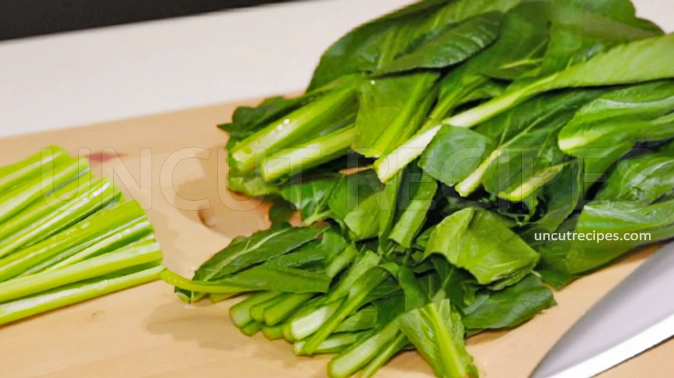
03 - For the Aburaage, you'll want to cut them into strips. Each strip should be about 1cm (or about 0.5inches) wide. Set aside.
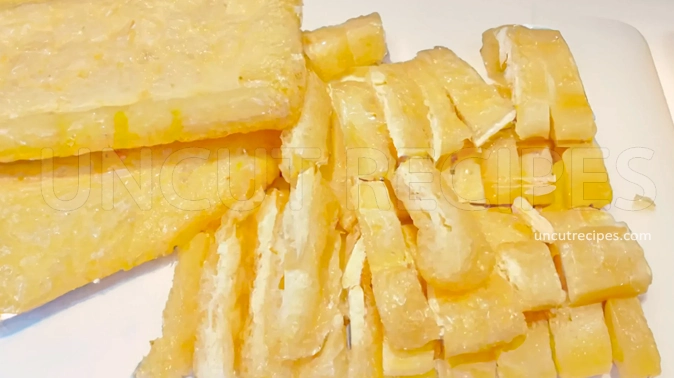
Creating the Flavorful Broth:
04 - Take a pot and pour in the Dashi.
05 - To the Dashi, add the Sugar, Soy Sauce, Mirin, and Sake. Warm it up, blending the flavors together.
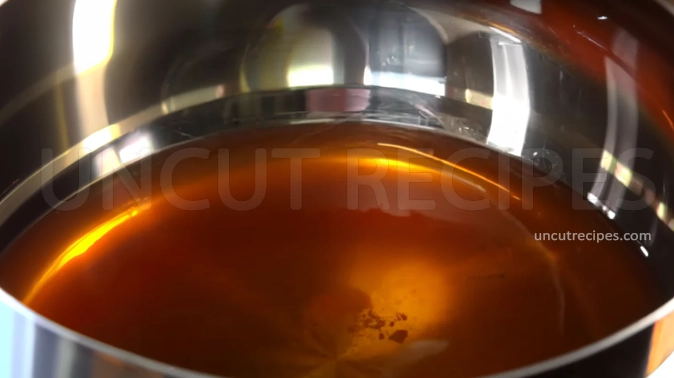
Cooking the Komatsuna and Aburaage:
06 - Once the broth is ready, introduce the Komatsuna and Aburaage strips. Let them simmer for a few minutes. You'll know they're ready when they become tender and have absorbed some of the broth's flavors.
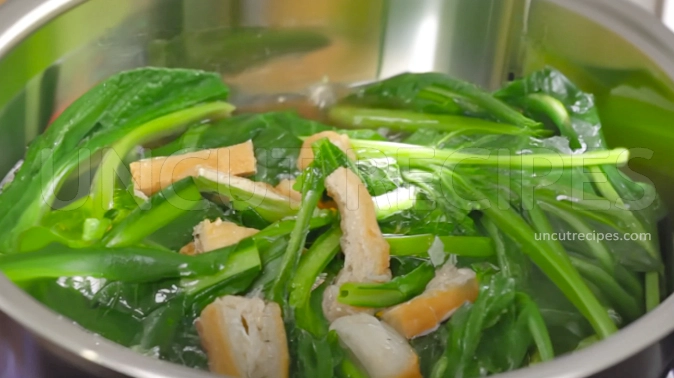
Finishing Touches:
07 - Turn off the heat and cover the pot. Allow everything to cool down.
08 - When serving, you can offer it at room temperature, or if you prefer, gently reheat it. Enjoy!
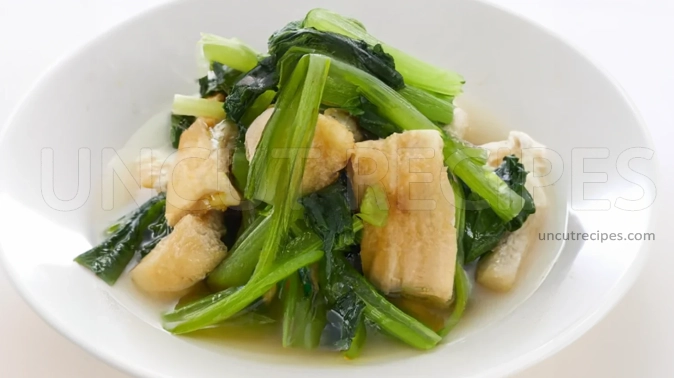
Notes:
Refrigerated Storage: Once cooked, you can store the Komatsuna Nibitashi in an airtight container in the fridge for up to 2-3 days. Reheat gently before serving if desired.
Cooking Ahead of Time: You can prepare the flavorful broth in advance. Once prepared, store it in the fridge and use it within 2-3 days. When ready to cook, just reheat the broth and proceed with the rest of the recipe steps.
Pressure Cooker/Instant Pot: You can use this appliance to speed up the simmering process. Use the sauté setting to warm up and blend the broth ingredients. Then, add Komatsuna and Aburaage, set it to 'low pressure' and cook for 1-2 minutes.
Vegetarian Alternative: To make this dish vegetarian, use a seaweed-based dashi like Kombu or a mushroom-based dashi like Shiitake instead of Bonito Dashi. Ensure that the Aburaage you use hasn't been fried in animal-derived oil.
Serving: Komatsuna Nibitashi pairs well with steamed rice as its mild broth complements the neutral taste of rice. You can also garnish with thinly sliced green onions or sesame seeds for added flavor and texture.
Nutritional Information
( Per Portion )
|
Calories |
131 kcal (6.55%) |
| Total Carbohydrate | 11g (3.67%) |
| Cholesterol | 0mg (0%) |
|
Total Fat |
5g (8.26%) |
| Saturated Fat | 1g (4.76%) |
| Polyunsaturated Fat | 1g (6.06%) |
| Monounsaturated Fat | 2g (7.14%) |
| Trans Fat | 0g (0%) |
| Fibers | 2g (6.35%) |
| Protein | 4g (7.84%) |
| Sugar | 6g (24%) |
|
Vitamin A |
500 IU (62.5%) |
|
Vitamin B1 (Thiamin) |
0.1mg (8.7%) |
| Vitamin B2 (Riboflavin) | 0.05mg (4.17%) |
| Vitamin B3 (Niacin) | 0.5mg (3.13%) |
| Vitamin B5 (Pantothenic Acid) | 0.5mg (10%) |
| Vitamin B6 | 0.1mg (7.69%) |
| Vitamin B7 (Biotin) | 5mcg (16.67%) |
| Vitamin B9 (Folate) | 30mcg (7.5%) |
| Vitamin B12 | 0.5mcg (20.83%) |
| Vitamin C | 20mg (24.24%) |
| Vitamin D | 0 IU (0%) |
| Vitamin E | 1mg (6.67%) |
| Vitamin K | 40mcg (38.1%) |
| Choline | 50mg (10.26%) |
| Carnitine | 10mg |
|
Calcium |
100mg (10%) |
|
Chloride |
0.5mg (0.02%) |
| Chromium | 5mcg (16.67%) |
| Copper | 0.2mg (0.022%) |
| Fluoride | 0.1mcg (0.002%) |
| Iodine | 10mcg (6.67%) |
| Iron | 1mg (7.69%) |
| Magnesium | 30mg (8.11%) |
| Manganese | 0.5mg (24.39%) |
| Molybdenum | 10mcg (22.22%) |
| Phosphorus | 50mg (7.14%) |
| Potassium | 300mg (6.38%) |
| Selenium | 5mcg (9.09%) |
| Sodium | 0.5mg (0.02%) |
| Sulfur | 0.005mg (0.05%) |
| Zink | 1mg (10.53%) |
* Percent Daily Values are based on a 2,000 calorie diet. Your daily values may be higher or lower depending on your calorie needs.
** Nutrient information is available for all ingredients in this recipe. Amount is based on available nutrient data collected from all over the internet.
(-) Information is not currently available for this nutrient. If you are following a medically restrictive diet, please consult your doctor or registered dietitian before preparing this recipe for personal consumption. |
| Written by: Uncut Recipes | Disclaimer |






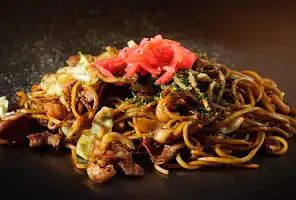







October 05, 2023
I was a bit hesitant at first, but this Komatsuna Nibitashi recipe is really tasty! Holy! Will definitely make it again! Thanks!